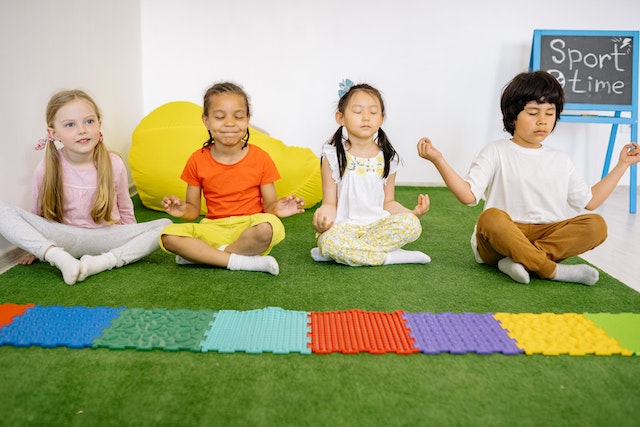Mindfulness is the practice of being present and aware of one’s thoughts, feelings, and surroundings.
It is the state of being mentally aware of both internal and external experiences. Mindfulness is not sitting on a mat with eyes closed and doing meditation only as many would believe if they were asked about mindfulness. While meditation mindfulness is real, the concept of mindfulness alone includes more than that.
Baer (2003) defines meditation as “the nonjudgmental observation of the ongoing stream of internal and external stimuli as they arise.” Mindfulness is an old concept of eastern culture and to simply, can be understood as being attentive on purpose.
Why is it important to teach kids about mindfulness?
Teaching kids about mindfulness is important for several reasons:
- Mindfulness can help reduce stress and anxiety: Mindfulness helps children to be more aware of their thoughts and emotions, which can help them manage stress and anxiety more effectively.
- Mindfulness can improve focus and attention: Mindfulness helps children to focus and pay attention to the present moment, which can improve their ability to concentrate and complete tasks.
- Mindfulness can improve emotional regulation: Mindfulness helps children to regulate their emotions, which can help them manage difficult feelings such as anger and frustration more effectively.
- Mindfulness can improve social skills: Mindfulness can help children to be more empathetic and understanding towards others, which can improve their social skills and relationships.
- Mindfulness can improve physical health: Mindfulness has been shown to improve physical health by reducing blood pressure, improving sleep, and reducing symptoms of chronic pain.
- Mindfulness can foster self-awareness: Mindfulness helps children to be more self-aware and understand their thoughts, emotions, and actions. This can help them to make better decisions and navigate complex social situations.
- Mindfulness can foster creativity: Mindfulness can help children to be more open-minded and curious, which can foster creativity and experimentation.
- Mindfulness can foster a growth mindset: Mindfulness can help children to develop a growth mindset, which is the belief that abilities and intelligence can be developed through effort and learning.
- Mindfulness can foster compassion and kindness: Mindfulness can help children to be more compassionate and kind towards others, which can lead to a more positive and supportive community.
Mindfulness activities for kids – age by age guide
Mindfulness activities can be beneficial for children of all ages. Here is a guide for age-appropriate mindfulness activities for kids:
For young children (ages 3-5):
- Sensory exploration: Encourage children to explore their senses by smelling different spices, feeling different textures, or tasting different foods.
- Body scan: Teach children to focus on different parts of their body, such as their feet, hands, or stomach, and notice how they feel.
- Breathing exercises: Teach children to take deep breaths and focus on the sensation of the air entering and leaving their body.
- Mindful listening: Encourage children to close their eyes and listen to different sounds in the environment, such as birds singing or water flowing.
For children (ages 6-8):
- Mindful coloring: Encourage children to focus on coloring and notice the different colors, shapes, and patterns.
- Yoga: Introduce children to simple yoga poses and encourage them to focus on their breath and body movements.
- Gratitude journal: Encourage children to write down things they are grateful for each day.
- Mindful walking: Encourage children to go for a walk and pay attention to the sights, sounds, and sensations around them.
For pre-teens (ages 9-12):
- Mindful eating: Encourage pre-teens to eat slowly and pay attention to the taste, texture, and smell of their food.
- Guided imagery: Teach pre-teens to use their imagination to visualize a peaceful scene, such as a beach or a forest.
- Mindful movement: Encourage pre-teens to engage in physical activities such as martial arts, dance or sports and encourage them to focus on the movement and the sensation in their bodies.
- Mindful observation: Encourage pre-teens to observe nature, whether it’s observing the clouds, stars or the movement of plants and animals.
For teens (ages 13-18):
- Mindful meditation: Encourage teens to practice meditation techniques, such as focusing on the breath or repeating a mantra.
- Reflection journal: Encourage teens to reflect on their thoughts and emotions in a journal.
- Mindful communication: Teach teens to listen actively and communicate mindfully with others.
- Mindful decision making: Encourage teens to consider the impact of their decisions on themselves and others, and to make decisions with mindfulness and awareness.
It’s important to remember that each child is unique and may respond differently to different activities, so it’s important to find what works best for each individual child.
Recommended reading: How to Get Kids Keep Their Stuff In Order?
Recommended reading: 23 Activities to Develop Critical Thinking Skills in Children
Mindfulness activities you can do as a family
Here are some mindfulness activities that families can do together:
- Mindful breathing: Sit together in a comfortable position and focus on taking slow, deep breaths. Encourage each family member to pay attention to the sensation of the breath entering and leaving their body.
- Mindful listening: Sit in silence and listen to the sounds around you. Encourage each family member to focus on different sounds, such as birds singing or cars passing by.
- Mindful walking: Take a walk together and encourage each family member to pay attention to the sights, sounds, and sensations around them.
- Yoga: Practice yoga together and focus on the breath and body movements.
- Gratitude journal: Each family member writes down things they are grateful for each day.
- Mindful eating: Sit down together for a meal and encourage each family member to pay attention to the taste, texture, and smell of their food.
- Mindful observation: Take a walk in nature and encourage each family member to observe the natural world around them, such as the clouds, stars, or the movement of plants and animals.
- Guided imagery: Sit together and use your imagination to visualize a peaceful scene, such as a beach or a forest.
- Mindful storytelling: Encourage each family member to take turns telling a story and pay attention to the feelings and emotions that the story evokes.
- Mindful games: Play games together and encourage each family member to focus on the present moment and enjoy the experience.
Conclusion: Mindfulness Activities for Kids
It’s important to remember that each family member may respond differently to different activities, so it’s important to find what works best for each individual family member. Mindfulness can be done in many ways, it’s not limited to these activities, you can make mindfulness a part of your daily routine.




